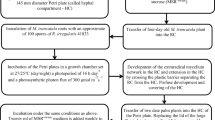Summary
Until now it has been presumed that the primary root of Zea mays L. dies very soon after the formation of the seedling. On the basis of this presumption maize root-system development has been used as an example for monocotyledons (z.B. Troll, 1937; Rauh, 1950).
After passing the seedling stage, monocotyledons are said to have shoot-born roots only. There are a few hints in the literature of exceptions to this principle known in the case of some palms (Falkenberg, 1876; Fitting, 1954; Kausch, unpublished). In this paper it is shown that the primary root of maize does not die off soon, but remains living during the entire vegetation period. Investigations were made within the greenhouse, where in the stage of flowering of the plants the primary root reached downwards into the soil as far as 1.60 m (see also Fig. 2). There are also some observations in the open field showing that here too the primary root remains living until the plant dies in autumn.
Nevertheless Zea mays has “sekundäre Homorhizie” and “heterogene Radication” (Troll, 1949). However, there is surely a large group within the monocotyledons which is capable of keeping the primary root system along with shoot-born roots. Of this group it may be said that it is of the “Mais-Wurzel-Typ.”
Zusammenfassung
An Gewächshauskulturen kann gezeigt werden, daß die Primärwurzel von Zea mays L. während der ganzen Lebensperiode der Pflanze perenniert. Da auch bei Phoenix dactylifera L. eine solche Tendenz zu erkennen ist, ist es wahrscheinlich, daß weitere Monocotylen diese Art der Bewurzelung zeigen. Es ließe sich daraus ein „Maiswurzeltyp” der heterogenen Radication bei den Monocotylen ableiten, bei dem primäres und sproßbürtiges Wurzelsystem dauernd nebeneinander bestehen.
Similar content being viewed by others
Literatur
Falkenberg, P.: Vergleichende Untersuchungen über der Bau der Vegetationsorgane der Monocotyledonen. Stuttgart: Ferdinand Enke 1876.
Fickendey, E. u. H. N. Blommendaal: Olpalme. In: Bangerts Ausland-Bücherei Nr. 35. Hamburg und Leipzig: Deutscher Auslandverlag 1929.
Fitting, H.: Lehrbuch der Botanik für Hochschulen, Abschnitt Morphologie, 26. Aufl. Stuttgart: Gustav Fischer 1954.
Goebel, K.: Vergleichende Entwicklungsgeschichte der Pflanzenorgane. In: Handbuch der Botanik, Bd. 3. Breslau: Trewendt 1884.
Rauh, W.: Morphologie der Nutzpflanzen. Heidelberg: Quelle & Meyer 1950.
Sideris, Ch. P.: Observations on the development of the root system of Allium cepa L. Amer. J. Bot. 12, 255 (1925).
Troll, W.: Vergleichende Morphologie der höheren Pflanzen, Bde. 1/1 u. 1/3. Berlin: Gebrüder Bornträger 1937 u. 1941–1943.
—: Über die Grundbegriffe der Wurzelmorphologie. Ost. bot. Z. 96, 444–452 (1949).
Author information
Authors and Affiliations
Rights and permissions
About this article
Cite this article
Kausch, W. Die Primärwurzel von Zea mays L.. Planta 73, 328–332 (1967). https://doi.org/10.1007/BF00385379
Received:
Issue Date:
DOI: https://doi.org/10.1007/BF00385379




